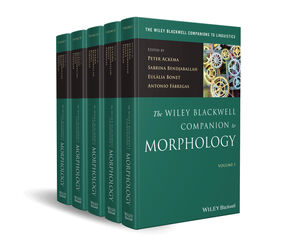ワイリー・ブラックウェル版 形態論大全(全5巻)
「統語論」「意味論」に続く21世紀の理論言語学の必携レファレンス!
ワイリー・ブラックウェル版 形態論大全(全5巻)
The Wiley Blackwell Companion to Morphology
(The Wiley Blackwell Companions to Linguistics)

Editors: Peter Ackema, Sabrina Bendjaballah, Eulàlia Bonet, & Antonio Fábregas
2023:10 5 vols. 2,208 p. set ISBN 978-1-119-69357-4
(Wiley-Blackwell) -US- 日本総代理店:㈱紀伊國屋書店
☆期間限定在庫特価10% OFF USD 895.5(※弊社在庫分のみ2025年8月31日まで適用)
Web販売価格 ¥148,791 / 標準価格 ¥196,024
通常価格 USD 995
Web販売価格 ¥163,583 / 標準価格 ¥217,805
*特価適用は弊社在庫に限り、在庫が完売しお取り寄せになる場合は通常価格に戻りますので、ご了承ください。
*2025年4月21日時点の価格です。実際の価格は、為替レートや出版社の都合により変動いたしますので、最新の価格は以下オンラインストアリンクをご参照ください。
*Web販売価格は、紀伊國屋書店BookWeb Proでご注文され、付帯作業を伴わない納品を行い、弊社標準書式による請求書を発行し遅滞なくお支払いただく場合、あるいは、クレジットカードでお支払いいただく場合に適用される販売価格です。
概要
言語学の一分野で、語の構造を分析対象とする「形態論」は、近年、学派を越えて活躍する言語学者レイ・ジャッケンドフが「並列構造」(parallel architecture)を提唱するなど、統語論や他の文法部門とのインターフェイスを探る言語理論の大きな潮流との関連でも、ひときわ注目を集めています。
言語学の各主要分野の最新・最良・最大の研究便覧として声価を確立しているシリーズ The Wiley Blackwell Companions to Linguistics から、「統語論大全」・「意味論大全」に続いて、遂に「形態論大全」も刊行されることになりました。斯界の著名研究者Peter Ackemaらを編者に迎えて、今日の代表的な形態論研究者たちが寄稿した全80章以上を収録する本書は、まさに形態論の百科事典、大全的な性格を備えています。形態論の歴史と発展から最前線、統語論や音韻論とのインターフェイスまでを網羅します。全て査読済みの各章は、テーマ別の「ケーススタディ」のかたちで、堅固な理論と実証的データに支えられた言語学的分析・説明・文脈化の何たるかを遺憾なく示す内容となっています。
言語の基本的な単位である語の研究を究めるために不可欠のプラットフォームとなるであろう本書は、形態論はもちろん、理論言語学全体で共有すべきレファレンスとして、広くおすすめできます。
※ページ下部にて、収録項目明細と寄稿者情報もご案内いたします。
ご購入サイト
- 紀伊國屋書店でご購入(一般の方向け):紀伊國屋書店ウェブストア
- 紀伊國屋書店でご購入(法人の方向け):紀伊國屋書店BookWeb Pro
※本件についてのお問い合わせ、お見積りについては、最寄りの紀伊國屋書店営業所もしくはこちらのお問い合わせフォームまでご連絡ください。
収録項目明細
Volume I
- Ablaut (Markus A. Pöchtrager and Connor G. Youngberg)
- Agent Nominalizations (Artemis Alexiadou)
- Agreement and the Realization of Arguments (Michelle Yuan and Matthew Tyler)
- Anaphoric Islands: A History of a Misleading Geographical Metaphor (Gregory Ward and Richard Sproat)
- Argument Structure and Derived Nominals (Hagit Borer)
- Avoidance of Unintended Repetition (Noam Faust)
- Back-formations and Subtractive Morphology: Subtractive Processes in German Dialects (Björn Köhnlein)
- Blending (Vincent Renner)
- Blocking Effects (David Embick, Johanna Benz, and Lefteris Paparounas)
- Borrowing of Morphology: With a Case Study of Baltic and Slavic Verbal Prefixes (Peter Arkadiev and Kirill Kozhanov)
- Case Stacking (Pavel Caha)
- Category Change without Overt Marking (Jan Don)
- Circumfixation (Franc Lanko Marušicˇ)
- Clipping and Truncation (Birgit Alber and Sabine Arndt-Lappe)
Volume II
- Clitic Cluster Restrictions (Diego Pescarini)
- Coordination and Gapping in Words (Rui P. Chaves)
- Coordinative Compounding, Including Dvandva (Laurie Bauer)
- Defectiveness (Andrea D. Sims)
- Deflexion (Cynthia L. Allen)
- Degree Morphology (Karen De Clercq, Pavel Caha, Michal Starke, and Guido Vanden Wyngaerd)
- Deponency (Laura Grestenberger)
- Elative Compounds (Jack Hoeksema)
- Endoclisis and Mesoclisis (Berthold Crysmann and Ana R. Luís)
- Evaluative Morphology: Universals and Variation (Elizabeth Ritter and Martina Wiltschko)
- Exocentric Compounds (Susan Olsen)
- Expletive Insertion (Patrik Bye)
- Gender and Its Morphological Effects (Maria-Rosa Lloret)
- Grammaticalization (Bernd Heine)
- Honorificity (Akitaka Yamada 山田 彬尭・大阪大学准教授)
Volume III
- Idioms in Morphology (Martin Everaert)
- Incorporation (Johanna Mattissen)
- Inflection Class Systems (Sacha Beniamine and Olivier Bonami)
- Inward and Outward Allomorph Selection (Nicholas Rolle)
- Linking Elements: A Case Study on Dutch (Marijke De Belder)
- Metathesis (Jane Chandlee)
- Mixed Categories (Petra Sleeman)
- Modal Adjectives (Isabel Oltra-Massuet and Elena Castroviejo)
- Morphological Manifestations of Aspect in Slavic (Olga Borik)
- Morphological Restrictions on Vowel Harmony: The Case of Hungarian (Péter Rebrus, Péter Szigetvári, and Miklós Törkenczy)
- Morphology of Passives (Patricia Cabredo Hofherr)
- Morphology of Pro-Drop (Ad Neeleman and Kriszta E. Szendro˝i)
- Morphology in Sign Languages: Theoretical Issues and Typological Contrasts (Roland Pfau and Markus Steinbach)
- Morphophonological Asymmetries in Affixation (Renate Raffelsiefen)
Volume IV
- Multiple and Cumulative Exponence (Paula Fenger)
- Mutation in Celtic (Pavel Iosad)
- Neoclassical Word Formation (Chiara Melloni)
- Non-Segmental Morphology (Eva Zimmermann)
- Noun Class Agreement in Niger-Congo Languages (Denis Creissels)
- Number Names: Internal Structure and Morphological Marking (Norbert Corver and Yuta Tatsumi 辰己 雄太・明海大学)
- Order of Valency-changing Morphemes (Alex Alsina)
- Ordering Restrictions between Affixes (Stela Manova)
- Parasynthesis (Jaume Mateu)
- Phonological Asymmetries between Roots and Affixes (Maria Gouskova)
- Phonologically Conditioned Allomorphy (Eulàlia Bonet)
- Phrasal Affixation (Asl Göksel and Metin Bagriacik)
- Phrases inside Words (Holden Härtl and Marcel Schlechtweg)
- Pluralia tantum and singularia tantum (Paolo Acquaviva and Laure Gardelle)
- Polysemy of Affixes: A Slavic Perspective (Laura A. Janda)
Volume V
- Polysynthesis (Richard Compton and Heather Bliss)
- Possessor Agreement (Katalin É. Kiss)
- Priscianic Word Formation: Morphomes, Referrals and Alternatives (Donca Steriade)
- Prominence Hierarchies in Agreement, with Special Reference to Menominee (Monica Macaulay)
- Recursion in Morphology (Taylor L. Miller and Hannah Sande)
- Reduplication (Robert Kennedy)
- Rich Agreement and Verb Movement (Olaf Koeneman, Seid Tvica, and Hedde Zeijlstra)
- Root and Pattern in Semitic – and Beyond (Noam Faust and Nicola Lampitelli)
- Suffix Order Restrictions in Bantu (Hannah Gibson, Nancy C. Kula, Lutz Marten, and Julius Taji)
- Suppletion (Andrew Hippisley)
- Suspended Affixation (James Hye Suk Yoon)
- Syncretism: Recurring Patterns (Johannes Hein and Philipp Weisser)
- Synthetic Compounding (Pius ten Hacken)
- Synthetic versus Analytic Expressions (Víctor Acedo-Matellán)
- Word-internal Inflection (Jeffrey Punske)
寄稿者情報
- Victor Acedo-Matellan, University of Oxford, UK
Synthetic versus Analytic Expressions, V - Paolo Acquaviva, University College Dublin, Ireland
Pluralia tantum and singularia tantum, IV - Birgit Alber, Free University of Bozen-Bolzano, Italy
Clipping and Truncation, I - Artemis Alexiadou, Leibniz-Zentrum Allgemeine Sprachwissenschaft (ZAS) and
Humboldt Universitat zu Berlin, Germany
Agent Nominalizations, I - Cynthia L. Allen, Australian National University, Australia
Deflexion, II - Alex Alsina, Pompeu Fabra University, Barcelona, Spain
Order of Valency-changing Morphemes, IV - Peter Arkadiev, Johannes-Gutenberg University of Mainz, Germany
Borrowing of Morphology: With a Case Study of Baltic and Slavic Verbal
Prefixes, I - Sabine Arndt-Lappe, University of Trier, Germany
Clipping and Truncation, I - Metin Bagriacik, Bo˘gazici University, Turkey
Phrasal Affixation, IV - Laurie Bauer, Victoria University of Wellington, New Zealand
Coordinative Compounding, Including Dvandva, II - Sacha Beniamine, University of Surrey, UK
Inflection Class Systems, III - Johanna Benz, University of Pennsylvania, USA
Blocking Effects, I - Heather Bliss, Simon Fraser University, British Columbia, Canada
Polysynthesis, V - Olivier Bonami, Universite Paris Cite, Laboratoire de linguistique formelle, CNRS,
France
Inflection Class Systems, III - Eulalia Bonet, Universitat Autonoma de Barcelona, Spain
Phonologically Conditioned Allomorphy, IV - Hagit Borer, Queen Mary University of London, UK
Argument Structure and Derived Nominals, I - Olga Borik, Universidad Nacional de Educacion a Distancia (UNED), Spain
Morphological Manifestations of Aspect in Slavic, III - Patrik Bye, Nord University, Norway
Expletive Insertion, II - Pavel Caha, Masarykova Univerzita, Czech Republic
Case Stacking, I
Degree Morphology, II - Elena Castroviejo, Universidad del Pais Vasco/Euskal Herriko Unibertsitatea, Spain
Modal Adjectives, III - Jane Chandlee, Haverford College, PA
Metathesis, III - Rui P. Chaves, University at Buffalo, State University of New York, USA
Coordination and Gapping in Words, II - Richard Compton, Universite du Quebec a Montreal, Quebec, Canada
Polysynthesis, V - Norbert Corver, Utrecht University, Netherlands
Number Names: Internal Structure and Morphological Marking, IV - Denis Creissels, University of Lyon, France
Noun Class Agreement in Niger-Congo Languages, IV - Berthold Crysmann, CNRS and University Paris Cite, France
Endoclisis and Mesoclisis, II - Marijke De Belder, Carl von Ossietzky Universitat Oldenburg, Germany
Linking Elements: A Case Study on Dutch, III - Karen De Clercq, CNRS/LLF/Universite Paris Cite, France
Degree Morphology, II - Jan Don, Open University, The Netherlands
Category Change without Overt Marking, I - David Embick, University of Pennsylvania, USA
Blocking Effects, I - Martin Everaert, Utrecht University, The Netherlands
Idioms in Morphology, III - Noam Faust, Universite Paris 8/CNRS Structures Formelles du Langage, France;
Universite Paris 8/CNRS SFL, France
Avoidance of Unintended Repetition, I
Root and Pattern in Semitic – and Beyond, V - Paula Fenger, University of Leipzig, Germany
Multiple and Cumulative Exponence, IV - Laure Gardelle, Universite Grenoble Alpes, France
Pluralia tantum and singularia tantum, IV - Hannah Gibson, University of Essex, UK
Suffix Order Restrictions in Bantu, V - Aslı Goksel, Bo˘gazici University, Turkey
Phrasal Affixation, IV - Maria Gouskova, New York University, NY, USA
Phonological Asymmetries between Roots and Affixes, IV - Laura Grestenberger, Austrian Academy of Sciences, Austria
Deponency, II - Pius ten Hacken, University of Innsbruck, Austria
Synthetic Compounding, V - Holden Hartl, Universitat Kassel, Germany
Phrases inside Words, IV - Johannes Hein, Humboldt University of Berlin, Germany
Syncretism: Recurring Patterns, V - Bernd Heine, University of Cologne, Germany
Grammaticalization, II - Andrew Hippisley, Wichita State University, KS
Suppletion, V - Jack Hoeksema, University of Groningen, The Netherlands
Elative Compounds, II - Patricia Cabredo Hofherr, Centre National de la Recherche Scientifique, Universite
Paris-8 and Universite Paris-Lumieres, France
Morphology of Passives, III - Pavel Iosad, University of Edinburgh, UK
Mutation in Celtic, IV - Laura A. Janda, The Arctic University of Tromso, Norway
Polysemy of Affixes: A Slavic Perspective, IV - Robert Kennedy, University of California, CA
Reduplication, V - Katalin E. Kiss, Hungarian Research Centre for Linguistics, Hungary
Possessor Agreement, V - Olaf Koeneman, Radboud University, Nijmegen, Netherlands
Rich Agreement and Verb Movement, V - Bjorn Kohnlein, The Ohio State University, OH, USA
Back-formations and Subtractive Morphology : Subtractive Processes in German
Dialects, I - Kirill Kozhanov, University of Potsdam, Germany
Borrowing of Morphology: With a Case Study of Baltic and Slavic Verbal
Prefixes, I - Nancy C. Kula, University of Essex, UK
Suffix Order Restrictions in Bantu, V - Nicola Lampitelli, Universite de Tours/CNRS LLL, France
Root and Pattern in Semitic – and Beyond, V - Franc Lanko Marušiˇc, University of Nova Gorica, Slovenia
Circumfixation, I - Maria-Rosa Lloret, Universitat de Barcelona, Spain
Gender and Its Morphological Effects, II - Ana R. Luis, University of Coimbra, Portugal
Endoclisis and Mesoclisis, II - Monica Macaulay, University of Wisconsin-Madison, WI
Prominence Hierarchies in Agreement, with Special Reference
to Menominee, V - Stela Manova, University of Vienna, Austria
Ordering Restrictions between Affixes, IV - Lutz Marten, SOAS University of London, UK
Suffix Order Restrictions in Bantu, V - Jaume Mateu, Universitat Autonoma de Barcelona, Spain
Parasynthesis, IV - Johanna Mattissen, University of Cologne, Germany
Incorporation, III - Chiara Melloni, University of Verona, Italy
Neoclassical Word Formation, IV - Taylor L. Miller, SUNY, Oswego
Recursion in Morphology, V - Ad Neeleman, University College London, UK
Morphology of Pro-Drop, III - Susan Olsen, Humboldt-Universitat Berlin, Germany
Exocentric Compounds, II - Isabel Oltra-Massuet, Universitat Rovira i Virgili, Spain
Modal Adjectives, III - Lefteris Paparounas, University of Pennsylvania, USA
Blocking Effects, I - Diego Pescarini, CNRS and Universite Cote d’Azur, France
Clitic Cluster Restrictions, II - Roland Pfau, University of Amsterdam, The Netherlands
Morphology in Sign Languages: Theoretical Issues and Typological
Contrasts, III - Markus A. Pochtrager, University of Vienna, Austria
Ablaut, I - Jeffrey Punske, Southern Illinois University
Word-internal Inflection, V - Renate Raffelsiefen, Leibniz-Institut fur Deutsche Sprache, Germany
Morphophonological Asymmetries in Affixation, III - Peter Rebrus, Hungarian Research Centre for Linguistics/Eotvos Lorand University,
Hungary
Morphological Restrictions on Vowel Harmony: The Case of Hungarian, III - Vincent Renner, Universite Lumiere Lyon 2, France
Blending, I - Elizabeth Ritter, University of Calgary, Canada
Evaluative Morphology: Universals and Variation, II - Nicholas Rolle, Leibniz-ZAS, Germany
Inward and Outward Allomorph Selection, III - Hannah Sande, University of California, Berkeley
Recursion in Morphology, V - Marcel Schlechtweg, Carl von Ossietzky Universitat Oldenburg, Germany
Phrases inside Words, IV - Andrea D. Sims, The Ohio State University, OH
Defectiveness, II - Petra Sleeman, University of Amsterdam, The Netherlands
Mixed Categories, III - Richard Sproat, Google, Japan
Anaphoric Islands: A History of a Misleading Geographical Metaphor, I - Michal Starke, Masarykova Univerzita, Czech Republic
Degree Morphology, II - Markus Steinbach, University of Gottingen, Germany
Morphology in Sign Languages: Theoretical Issues and Typological
Contrasts, III - Donca Steriade, Massachusetts Institute of Technology, Cambridge, Massachusetts
Priscianic Word Formation: Morphomes, Referrals and Alternatives, V - Kriszta E. Szendr˝ oi, University of Vienna, Austria
Morphology of Pro-Drop, III - Peter Szigetvari, Eotvos Lorand University, Hungary
Morphological Restrictions on Vowel Harmony: The Case of Hungarian, III - Julius Taji, University of Dar es Salaam, Tanzania
Suffix Order Restrictions in Bantu, V - Yuta Tatsumi 辰己 雄太, Meikai University, Japan 明海大学
Number Names: Internal Structure and Morphological Marking, IV - Miklos Torkenczy, Eotvos Lorand University/Hungarian Research Centre
for Linguistics, Hungary
Morphological Restrictions on Vowel Harmony: The Case of Hungarian, III - Seid Tvica, Georg-August-Universitat Gottingen, Germany
Rich Agreement and Verb Movement, V - Matthew Tyler, University of Cambridge, UK
Agreement and the Realization of Arguments, I - Gregory Ward, Northwestern University, IL
Anaphoric Islands: A History of a Misleading Geographical Metaphor, I - PhilippWeisser, University of Leipzig, Germany
Syncretism: Recurring Patterns, V - MartinaWiltschko, ICREA, Universitat Pompeu Fabra, Spain
Evaluative Morphology: Universals and Variation, II - Guido Vanden Wyngaerd, KU Leuven, Belgium
Degree Morphology, II - Akitaka Yamada 山田 彬尭, Osaka University, Japan 大阪大学
Honorificity, II - James Hye Suk Yoon, University of Illinois
Suspended Affixation, V - Connor G. Youngberg, University of Essex, UK
Ablaut, I - Michelle Yuan, University of California San Diego, CA
Agreement and the Realization of Arguments, I - Hedde Zeijlstra, Georg-August-Universitat Gottingen, Germany
Rich Agreement and Verb Movement, V - Eva Zimmermann, University of Leipzig, Germany
Non-Segmental Morphology, IV
(学術洋書部)





